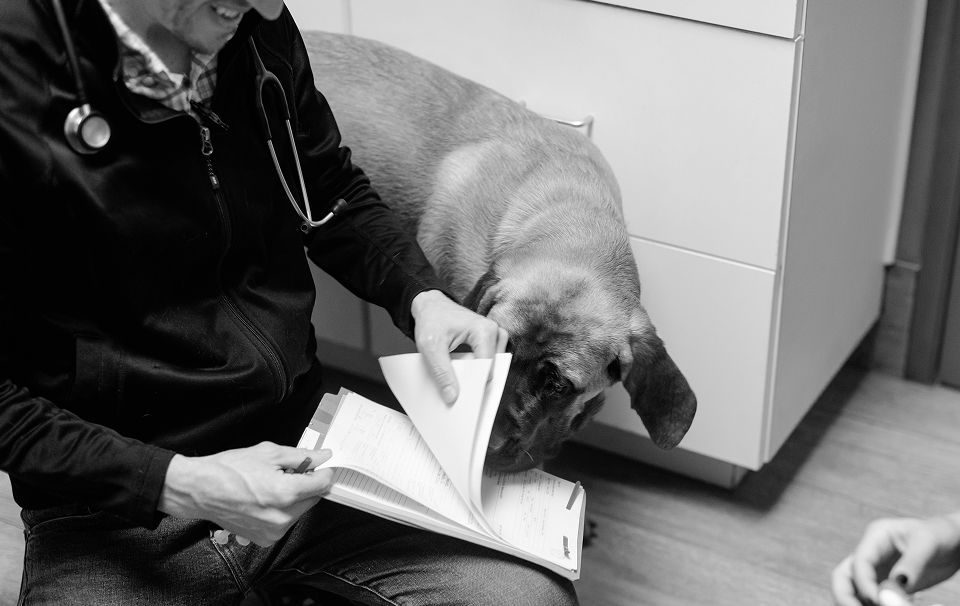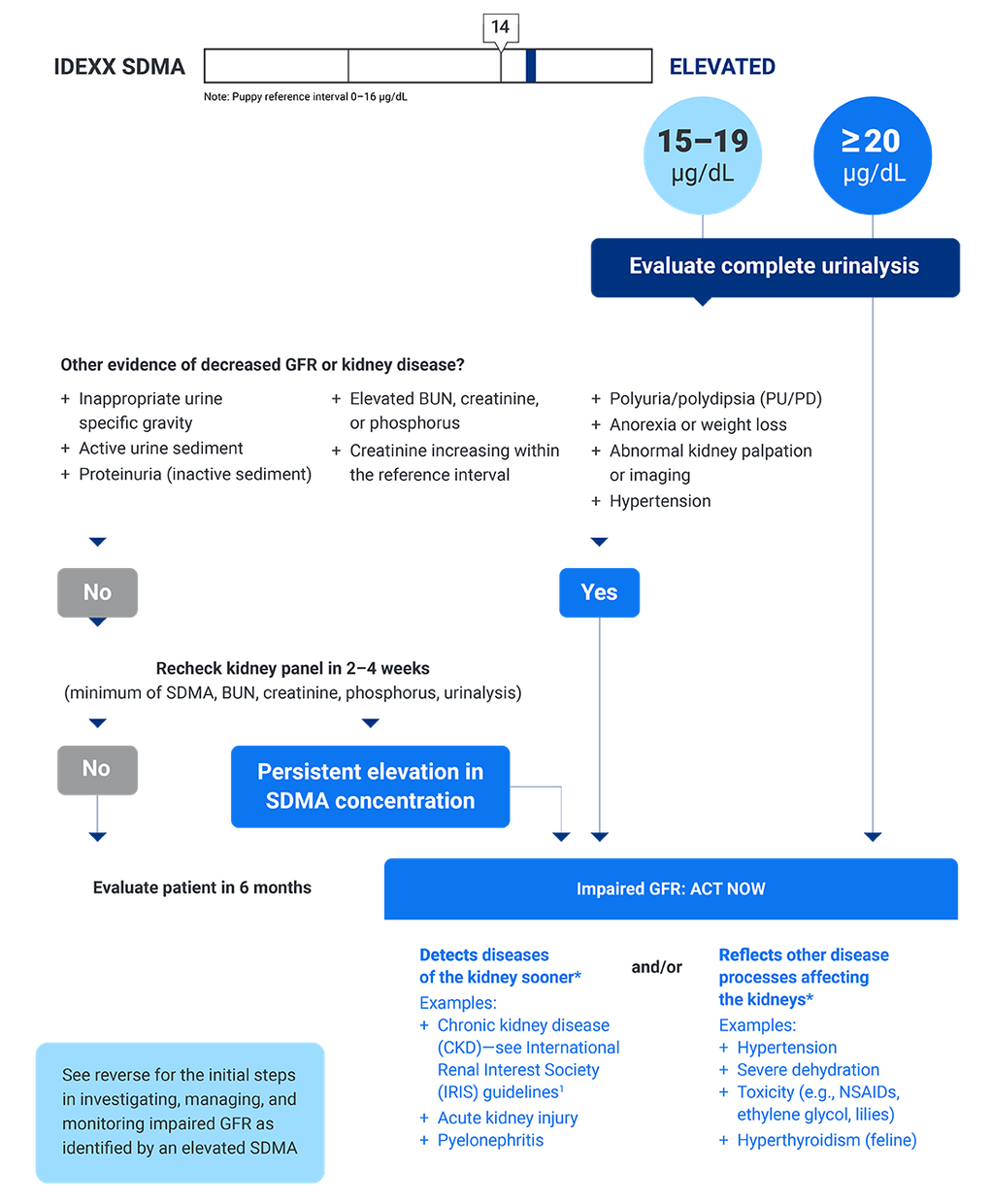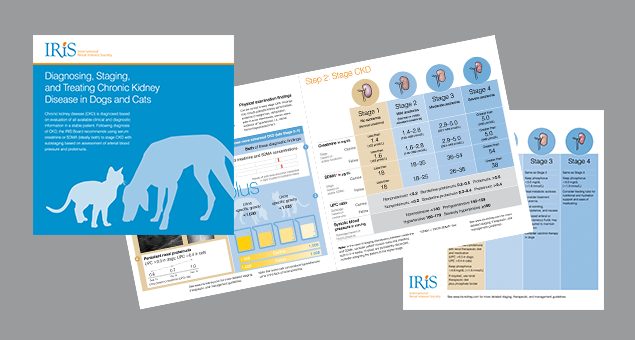
IDEXX SDMA testing
Interpreting test results and next steps.
Interpreting your SDMA results.
15–19 µg/dL
Take action when SDMA result is mildly elevated (15–19 μg/dL), and perform a complete urinalysis to determine if persistent evidence of kidney disease is found and establish next steps.
≥ 20 µg/dL
When SDMA result is ≥ 20 µg/dL, perform a complete urinalysis. Kidney disease is probable. Act immediately by following the protocol.
IDEXX SDMA algorithm
An elevated SDMA level indicates reduced glomerular filtration rate (GFR), often due to primary kidney disease or secondary issues like concurrent illness. Follow this algorithm to investigate, classify the issue, and manage ongoing care.

Investigate, manage, and monitor damaged GFR caused by elevated SDMA.
Investigate
Underlying cause, treatable condition, concurrent disease, and CKD.
Underlying cause
- Urinary tract infection (UTI)/pyelonephritis
- Toxicity (e.g., NSAIDs, ethylene glycol, lilies)
- Acute kidney Injury
- Systemic hypertension
- Chronic kidney disease (CKD)
Consider performing
- Urine culture and minimum inhibitory concentration (MIC) susceptibility
- Infectious disease testing
- Abdominal imaging
- Urine protein:creatine (UPC) ratio (proteinuria)
- Blood pressure
Concurrent condition to assess
- Hydration status
- Thyroid status (feline)
Manage
Treat underlying disease, manage assessed kidney injury, and adjust care protocols.
Treat appropriately
- Underlying disease (e.g., pyelonephritis, infectious disease)
- Dehydration
- Discontinue nephrotoxic medications (e.g., NSAIDs)
- Hypertension
- Proteinuria
Additional support
- Ample, clean water
- Renal therapeutic diet if warranted
Adjust anesthesia protocols
- Provide fluids (intravenous or subcutaneous)
- Oxygen support prior to, during, and after procedure
- Adjust pain management
Monitor
Manage and monitor outcomes.
Monitor renal biomarkers
Trended testing of the following:
- SDMA, urea, creatinine, and phosphorus
- Urinalysis
- Blood pressure
SDMA remains increased, but stable
- GFR remains impaired but stable
- Consider CKD diagnosis, refer to IRIS staging and treatment guidelines
- Institute appropriate supportive care and monitoring
SDMA continues to increase
- Ongoing active kidney injury
- Revisit investigate: repeat or additional diagnostics
- Institute ongoing supportive care
SDMA returns to normal
- Recovery from mild injury
- Response to appropriate therapy
- Compensatory mechanisms
- Recheck within 6 months–1 year

Stage CKD with IRIS staging guidelines.
The International Renal Interest Society (IRIS) created guidelines that make it easy to determine the stages of CKD and the treatment options that work best for both cats and dogs.
FAQs
An increased IDEXX SDMA concentration indicates decreased kidney function as a result of acute kidney injury (AKI), chronic kidney disease (CKD), or both and should never be ignored.1,2 An IDEXX SDMA concentration above the reference interval requires action to investigate, manage, and monitor using the IDEXX SDMA Test diagnostic algorithm.
Any increase in IDEXX SDMA concentration above the reference interval (greater than 14 µg/dL in cats and adult dogs;3,4 greater than 16 µg/dL in puppies5) is considered meaningful. Most animals with early kidney disease have an SDMA concentration between the upper end of the reference interval to 20 µg/dL. Since SDMA increases as kidney function decreases, an SDMA concentration greater than 20 µg/dL is typically seen in more advanced disease, along with an increased creatinine concentration. Fewer than 1% of all results will be above 50 µg/dL. The linearity of the assay extends to 100 µg/dL.3
Kidney disease is common, with 1 in 3 cats6 and 1 in 10 dogs7 developing some form of kidney disease over their lifetime. Recent studies suggest kidney disease is even more common and until now has been underrecognized.8 The IDEXX SDMA Test will help to recognize kidney disease in more animals earlier, with prevalence increasing with age. As kidney disease advances, creatinine will also be increased.9,10
SDMA is a surrogate marker of GFR, so any changes in SDMA are reflective of changing GFR, biological variation, and/or hydration status of the pet. SDMA is not affected by extrarenal factors, such as diet, muscle mass, or gastrointestinal bleeding.4,10,11
The reference interval for SDMA in cats is 0–14 μg/dL, with a reportable range up to 100 μg/dL. We recommend a complete urinalysis in addition to the IDEXX SDMA Test in order to more accurately interpret kidney function.
The IDEXX SDMA Test is a valuable measure of kidney function in pediatric patients as well as in adult animals, but it must be interpreted in light of age-appropriate reference intervals. No impact of age on SDMA reference intervals was observed in healthy unsedated kittens. The adult cat reference interval of 0–14 µg/dL is appropriate for use in kittens. In puppies, the IDEXX SDMA Test reference interval has been determined to be slightly higher (0–16 μg/dL) than the adult reference interval (0–14 μg/dL).5
Although the majority of puppies (90%) have results that fall within the adult reference interval, mildly increased SDMA levels (14–16 µg/dL) may be seen in a small proportion of puppies (6%) during the rapid growth phase. In these cases, it is recommended to evaluate a complete urinalysis and assess for other evidence of kidney disease and consider rechecking an SDMA level as the puppy’s growth phase slows.5
The SDMA reference interval normalizes as puppies achieve adulthood. The exact age at which an individual dog reaches maturity varies by breed, with toy breed dogs completing their rapid growth phase significantly earlier than giant breeds. The cause of this slight increase in IDEXX SDMA concentration in puppies is unknown at this time, but physiological roles for protein arginine methylation, including signal transduction, mRNA splicing, transcriptional control, DNA repair, and protein translocation, are postulated to be increased in growing animals, resulting in increased SDMA generation.5
If both IDEXX SDMA and creatinine concentrations are within their reference intervals, then kidney disease is unlikely. If both IDEXX SDMA and/or creatinine concentrations are at the upper end of the reference interval or they have been increasing within the reference interval, early kidney disease cannot be ruled out. A complete urinalysis should be performed to confirm there is no other evidence of kidney disease.9,10
This combination of results is uncommon.5 Hemolysis, if present, can result in decreased SDMA.3 SDMA and creatinine can both be affected by biologic and assay variability, resulting in fluctuations around the upper end of the reference interval; this can be seen with well-managed stable CKD, and results will likely align as disease progresses.4 Creatinine can exceed the reference interval in muscular dogs with normal kidney function. Creatinine can be artifactually increased postprandially. If kidney disease is still suspected, a complete urinalysis should be performed on all patients to evaluate for inappropriate specific gravity, proteinuria, or other evidence of kidney disease.9,10
Learn more about the comprehensive kidney care diagnostics and support available from IDEXX.
Note: SDMA is symmetric dimethylarginine.
*These IDEXX SDMA medical claims are supported by extensive scientific evidence.
References
- Dahlem DP, Neiger R, Schweighauser, et al. Plasma symmetric dimethylarginine concentrations in dogs with acute kidney injury and chronic kidney disease. J Vet Intern Med. 2017;31(3):799–804. doi:10.1111/jvim.14694
- Gori E, Pierini A, Lippi I, Meucci V, Perondi F, Marchetti V. Evaluation of symmetric dimethylarginine (SDMA) in dogs with acute pancreatitis. Vet Sci. 2020;7(2):72. doi:10.3390/vetsci7020072
- Nabity MB, Lees GE, Boggess MM, et al. Symmetric dimethylarginine assay validation, stability, and evaluation as a marker for early detection of chronic kidney disease in dogs. J Vet Intern Med. 2015;29(4):1036–1044. doi:10.1111/jvim.12835
- Kopke MA, Burchell RK, Ruaux CG, Burton SE, Lopez-Villalobos N, Gal A. Variability of symmetric dimethylarginine in apparently healthy dogs. J Vet Intern Med. 2018;32(2):736–742. doi:10.1111/jvim.15050
- Data on file at IDEXX Laboratories, Inc. Westbrook, Maine USA.
- Lulich JP, Osborne CA, O’Brien TD, Polzin DJ. Feline renal failure: questions, answers, questions. Compend Contin Educ Pract Vet. 1992;14(2)127–153.
- Van Vertloo L. Renal dysfunction in dogs and cats. Merck Veterinary Manual. Merck & Co, Inc; 2025. Updated March 2025. Accessed July 21, 2025. www.merckvetmanual.com/urinary-system/noninfectious-diseases-of-the-urinary-system-in-small-animals/renal-dysfunction-in-dogs-and-cats
- Perini-Perera S, Del-Ángel-Caraza J, Pérez-Sánchez AP, Quijano-Hernández IA, Recillas-Morales S. Evaluation of chronic kidney disease progression in dogs with therapeutic management of risk factors. Front Vet Sci. 2021;8:621084. doi:10.3389/fvets.2021.621084
- Hall JA, Yerramilli M, Obare E, Yerramilli M, Jewell DE. Comparison of serum concentrations of symmetric dimethylarginine and creatinine as kidney function biomarkers in cats with chronic kidney disease. J Vet Intern Med. 2014;28(6):1676–1683. doi:10.1111/jvim.12445
- Hall JA, Yerramilli M, Obare E, Yerramilli M, Almes K, Jewell DE. Serum concentrations of symmetric dimethylarginine and creatinine in dogs with naturally occurring chronic kidney disease. J Vet Intern Med. 2016;30(3):794–802. doi:10.1111/jvim.13942
- Hall JA, Yerramilli M, Obare E, Yerramilli M, Melendez LD, Jewell DE. Relationship between lean body mass and serum renal biomarkers in healthy dogs. J Vet Intern Med. 2015;29(3):808–814. doi:10.1111/jvim.12607